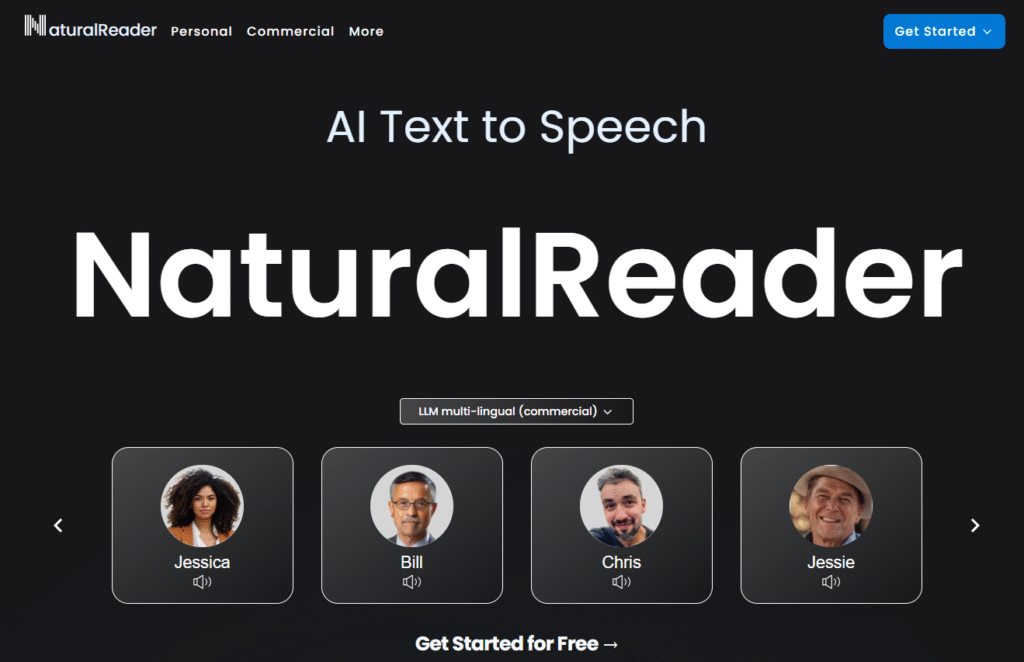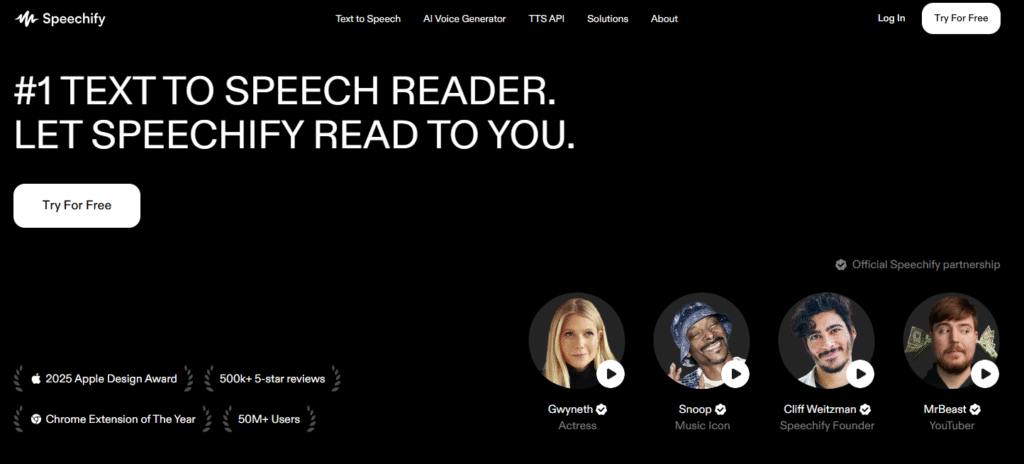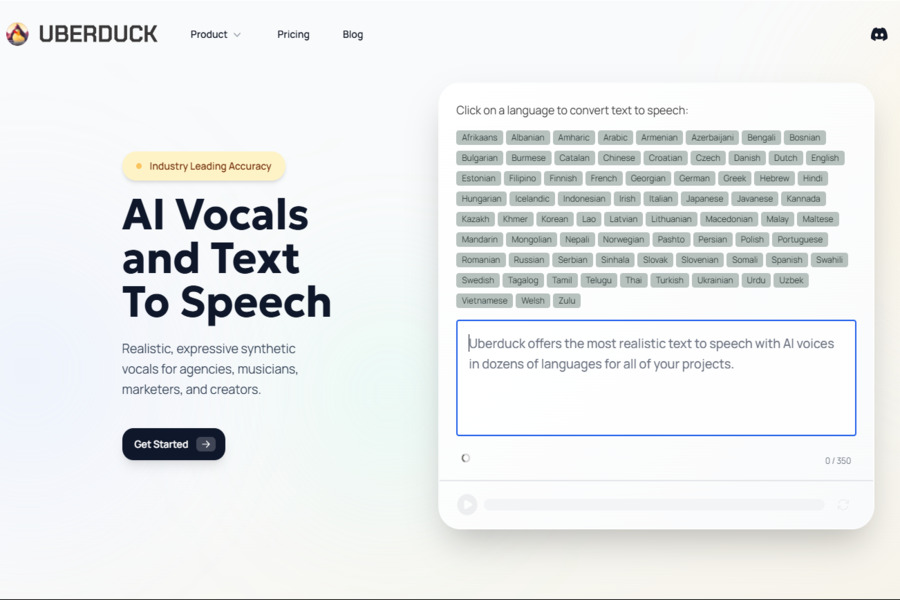If your current workflow with FakeYou feels like trying to win a Formula 1 race with a go-kart, you’ve come to the right place. Don’t get us wrong; FakeYou burst onto the scene as a wonderfully quirky, community-powered playground that made voice cloning accessible and fun. But let’s be honest—in 2025, content creators, marketers, and developers need more than just meme-worthy character impressions.
We need professional-grade quality, blazing speed, and ironclad security for our projects. This is precisely why the strategic search for a robust FakeYou alternative has become mission-critical for anyone serious about leveraging voice AI.
Sticking with the basics might just be holding your creativity hostage.
Top 6 FakeYou Alternatives in 2025
Ready to meet the tools that can truly elevate your projects? Here are the top six FakeYou alternatives making waves in 2025.
1. NaturalReader

NaturalReader began its life as assistive technology, and that user-focused DNA is still evident today. It excels at transforming a wide array of documents—from PDFs and Word files to PowerPoint presentations—into surprisingly natural-sounding audio across dozens of languages. What truly sets it apart is its genuine, built-in commitment to accessibility.
Features like synchronized text highlighting and dyslexia-friendly fonts aren’t mere afterthoughts; they are core to the entire experience. Its offline desktop app is a godsend for productivity on the go, allowing you to convert a 50-page report even on a flight without Wi-Fi.
Key Features:
- Supports over 20 file formats including PDF, DOCX, and EPUB
- Audio bookmarking and text annotation for active listening
- Full offline access via dedicated desktop applications
- Built-in assistive technology for dyslexic and visually impaired users
2. TTS Reader

If you’ve ever rage-quit an application because it demanded your email, credit card, and firstborn child just to run a simple test, TTS Reader will feel like a breath of fresh air. This web-based tool fires up instantly in your browser—no sign-in required—and handles text-to-speech conversion with absolutely zero friction. It won’t clone voices or generate fancy videos, but it excels magnificently at the fundamentals: reading articles aloud, proofreading your own scripts, and turning e-books into instant audiobooks.
Key Features:
- Instant web-based access with no registration barriers
- Multi-platform apps plus a streamlined and highly useful Chrome extension
- Offline functionality for uninterrupted productivity
- Ideal for converting long-form text into digestible audio content
3. Speechify

Speechify is built on the understanding that not everyone processes information the same way. Founded by individuals with dyslexia, it prioritizes genuinely human-like intonation and adaptive speed controls that actually work well. The voice modulation features are superb, allowing you to shift a voice from a “corporate presentation” tone to a “casual podcast” feel with a simple slider. The real-time translation feature also handily breaks down language barriers on the fly.
Key Features:
- Granular voice modulation and intonation control
- Real-time translation across multiple languages
- Adaptive reading speed that learns your personal preferences
- Seamless synchronization across all your devices and platforms
4. Murf.ai

Murf.ai feels like what you’d get if a professional voice actor and a brilliant software engineer had a baby. Its voice cloning is genuinely impressive; feed it just 30 minutes of clean audio, and you can get a custom voice that doesn’t sound like it just escaped from a robot factory. The interface strikes a rare and perfect balance: powerful enough for seasoned audio producers, yet intuitive enough for marketing teams that need to quickly whip up a voiceover for an explainer video.
Key Features:
- High-fidelity voice cloning with minimal training audio required
- Extensive library of lifelike voices with a full emotional range
- Robust API for seamless third-party integrations
- Precise control over pitch, tone, speed, and emphasis
5. Listnr AI

Listnr AI operates on the principle that content creation isn’t just about making something—it’s about making something that performs. With an astonishing library of over 900 voices spanning more than 140 languages, it covers more accents than most of us have ever heard of. But the real magic lies in its analytics dashboard, where you can track which voice styles drive more engagement, A/B test different tones, and optimize your audio based on real listener retention data.
Key Features:
- Expansive library of 900+ voices in 140+ languages and accents
- Built-in voice analytics to track engagement and performance
- Straightforward API integration for developers
- Optimized for scalable content production across multiple platforms
6. Resemble AI

Resemble AI is playing in an entirely different league. We’re talking about real-time voice cloning that can inject genuine, believable emotion—like excitement, sorrow, or urgency—into live conversations. Its multilingual support is staggering, covering over 120 languages with regional dialects so specific you’ll swear it’s a local speaker. For businesses, the AI watermarking using C2PA standards is a total game-changer, cryptographically proving your content is legitimate.
Key Features:
- Real-time TTS with authentic emotional modulation
- Support for 120+ languages and extensive regional accents
- Deep voice customization including tone, pitch, and energy
- Neural watermarking with C2PA standards for content protection
How to Choose the Right Text-to-Speech Platform
Selecting your voice AI soulmate isn’t about finding the universally “best” tool; it’s about finding the right tool for you. Let’s cut through the marketing fluff with a practical checklist.
Voice Quality
This is the foundation. Always listen to voice samples with your eyes closed. Does it sound like a real person you’d enjoy having coffee with, or a monotonous GPS giving you directions? Prioritize platforms that offer high-bitrate downloads and demonstrate clear emotional variance in their voices. Your audience’s ears will genuinely thank you for this diligence.
Flexibility Beats Flashiness Every Time
You need direct control over the core elements of speech. This includes the ability to adjust tone for different audiences, tweak speed for optimal comprehension, and use emphasis tools to highlight key points. If a platform doesn’t allow you to “direct” the vocal performance, you’re merely a passenger, not the creator, in your own project.
Think Globally, Sound Locally
Even if you only operate in English today, it is profoundly wise to choose a platform with robust multi-language support. The moment you decide to expand into Spanish, Japanese, or any other market, you’ll be incredibly grateful you planned ahead. Furthermore, accent diversity matters more than you might think—an Australian voice selling surf gear creates a completely different vibe than a Midwestern US twang.
Integration
For developers and teams, a great, well-documented API is crucial. It should allow your developers to integrate voice features seamlessly, without headaches. Before committing, ask about the availability of SDKs, the clarity of the documentation, and the platform’s rate limits. The best tools feel like they were always a native part of your tech stack, not a clunky, bolted-on afterthought.
Pricing
That $12/month plan might look cheap initially, but it becomes expensive the moment you hit its usage caps in the middle of a critical project. A smarter approach is to calculate your cost per minute of usable audio, not just the monthly subscription fee. While enterprise-level tools may seem expensive upfront, they often prove their value when you consider the alternative: hiring human voice actors at $200 or more per hour.
Conclusion on FakeYou Alternative
The AI voice landscape in 2025 has matured beautifully. It’s no longer about simply replacing humans; it’s about powerfully augmenting creators with intelligent tools that genuinely understand and integrate into their workflow. FakeYou served a valuable purpose as a fun and accessible gateway into the world of voice cloning, but the FakeYou alternatives we’ve explored offer something far more substantial: unwavering reliability, professional-grade quality, and a fundamental respect for your creative vision.
Whether you’re building accessible educational content with NaturalReader, churning out compelling marketing videos with Murf.ai, or deploying a sophisticated, multilingual customer support system with Resemble AI, the right tool is the one that seamlessly disappears into your creative process.



